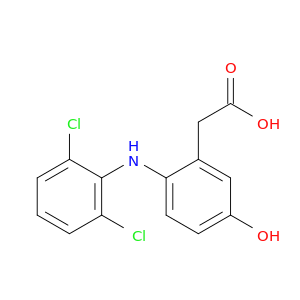
5-HYDROXY DICLOFENAC
| Title | Journal |
|---|---|
| An evaluation of myeloperoxidase-mediated bio-activation of NSAIDs in promyelocytic leukemia (HL-60) cells for potential cytotoxic selectivity. | Toxicology letters 20171005 |
| Diclofenac toxicity in human intestine ex vivo is not related to the formation of intestinal metabolites. | Archives of toxicology 20150101 |
| Human NAD(P)H:quinone oxidoreductase 1 (NQO1)-mediated inactivation of reactive quinoneimine metabolites of diclofenac and mefenamic acid. | Chemical research in toxicology 20140421 |
| One-electron oxidation of diclofenac by human cytochrome P450s as a potential bioactivation mechanism for formation of 2'-(glutathion-S-yl)-deschloro-diclofenac. | Chemico-biological interactions 20140125 |
| Metabolism related toxicity of diclofenac in yeast as model system. | Toxicology letters 20110205 |
| Input of selected human pharmaceutical metabolites into the Norwegian aquatic environment. | Journal of environmental monitoring : JEM 20110201 |
| Removal of diclofenac and mefenamic acid by the white rot fungus Phanerochaete sordida YK-624 and identification of their metabolites after fungal transformation. | Biodegradation 20100901 |
| Diclofenac oxidation by biogenic manganese oxides. | Environmental science & technology 20100501 |
| Degradation of the drug sodium diclofenac by Trametes versicolor pellets and identification of some intermediates by NMR. | Journal of hazardous materials 20100415 |
| Hepatic clearance of reactive glucuronide metabolites of diclofenac in the mouse is dependent on multiple ATP-binding cassette efflux transporters. | Molecular pharmacology 20100401 |
| Diclofenac hypersensitivity: antibody responses to the parent drug and relevant metabolites. | PloS one 20100101 |
| Occurrence of diclofenac and its metabolites in surface water and effluent samples from Karachi, Pakistan. | Chemosphere 20091001 |
| Occurrence of diclofenac and selected metabolites in sewage effluents. | The Science of the total environment 20081101 |
| Oxidation of diclofenac with ozone in aqueous solution. | Environmental science & technology 20080901 |
| Transformation of diclofenac by the indigenous microflora of river sediments and identification of a major intermediate. | Chemosphere 20070901 |
| Investigation of the immunogenicity of diclofenac and diclofenac metabolites. | Toxicology letters 20070110 |
| Efficient high performance liquid chromatograph/ultraviolet method for determination of diclofenac and 4'-hydroxydiclofenac in rat serum. | Journal of chromatography. B, Analytical technologies in the biomedical and life sciences 20060118 |
| Effects of phenobarbital on metabolism and toxicity of diclofenac sodium in rat hepatocytes in vitro. | Food and chemical toxicology : an international journal published for the British Industrial Biological Research Association 20041001 |
| Diclofenac-induced antibodies against red blood cells are heterogeneous and recognize different epitopes. | Transfusion 20040801 |
| Diclofenac and metabolite pharmacokinetics in children. | Paediatric anaesthesia 20040601 |
| Residue analysis of the pharmaceutical diclofenac in different water types using ELISA and GC-MS. | Environmental science & technology 20030801 |
| Diclofenac-induced inactivation of CYP3A4 and its stimulation by quinidine. | Drug metabolism and disposition: the biological fate of chemicals 20021001 |
| Mechanism-based inactivation of CYP2C11 by diclofenac. | Drug metabolism and disposition: the biological fate of chemicals 20010901 |